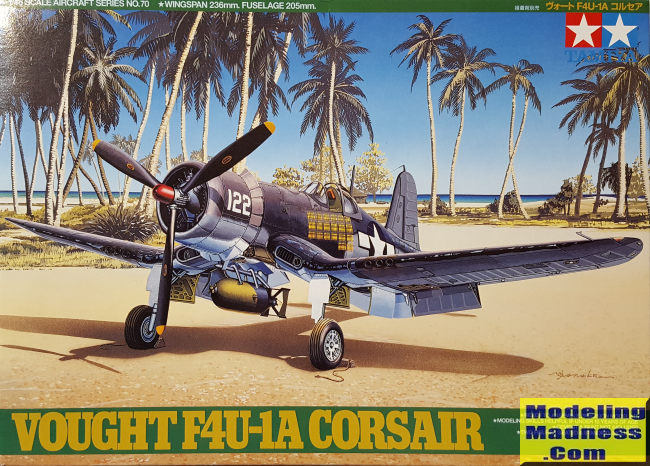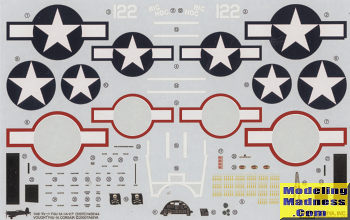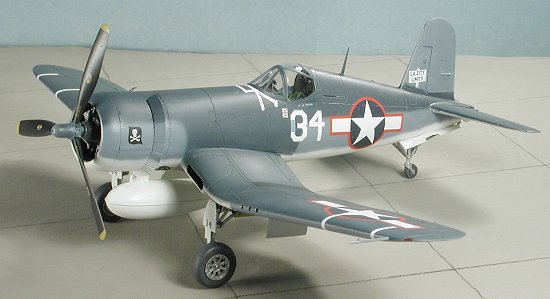
| KIT #: | 61070 |
| PRICE: | 2000 yen when new |
| DECALS: | Two options |
| REVIEWER: | Scott Van Aken |
| NOTES: | 2000 release |

| HISTORY |
F4U-1A (called Corsair Mk II by the Fleet Air Arm):
Mid-to-late production Corsairs incorporated a new, taller, wider canopy with only two frames — very close to what the Malcolm hood did for British fighter aircraft — along with a simplified windscreen; the new canopy design allowed the semi-elliptical turtledeck "flank" windows to be omitted. The designation F4U-1A to differentiate these Corsairs from earlier "birdcage" variants was allowed to be used internally by manufacturers. The pilot's seat was raised 7 in (180 mm) which, combined with the new canopy and a 6 in (150 mm) lengthening of the tailwheel strut, allowed the pilot better visibility over the long nose. In addition to these changes, the bombing window under the cockpit was omitted. These Corsairs introduced a 6 in (150 mm)-long stall strip just outboard of the gun ports on the right wing leading edge and improved undercarriage oleo struts which eliminated bouncing on landing, making these the first truly "carrier capable" F4Us.
Three hundred and sixty F4U-1As were delivered to the Fleet Air Arm. In British service, they were modified with "clipped" wings (8 in (200 mm) was cut off each wingtip) for use on British aircraft carriers, although the Royal Navy had been successfully operating the Corsair Mk I since 1 June 1943 when 1830 Naval Air Squadron was commissioned and assigned to HMS Illustrious. F4U-1s in many USMC squadrons had their arrester hooks removed. Additionally, an experimental R-2800-8W engine with water injection was fitted on one of the late F4U-1As. After satisfactory results, many F4U-1As were fitted with the new powerplant. The aircraft carried 237 US gal (900 L) in the main fuel tank, located in front of the cockpit, as well as an unarmored, non-self-sealing 62 US gal (230 L) fuel tank in each wing. This version of the Corsair was the first to be able to carry a drop tank under the center-section. With drop tanks fitted, the fighter had a maximum ferry range of just over 1,500 mi (2,400 km).
| THE KIT |
The Corsair is a favorite of modelers and over the years, there have been a number of kits in 1/48 scale. The oldest I can recall is the one by Monogram, which depicts, to a point, a late war F4U-4. Typical of Monogram of the time, it had working features that included folding wings. Next we had one by Otaki, which was an F4U-1A. Though somewhat basic, it was quite modern in design with engraved panel lines and good form. Even today, it makes into a very nice model. Next was Mania which did a nice F4U-4 with raised panel line detail. This company was bought by Hasegawa and later released under its own label. Later Hasegawa and Hobbycraft developed Corsairs about the same time. The Hasegawa was an F4U-5 while the Hobbycraft was an F4U-1D. Both can still be found and both make nice models when done.
In 2000, Tamiya did a full range of WWII Corsairs that included the Birdcage, this -1A, and a later -1D. These kits are all quite similar and provide the option for folding wings if you so desire. They also include lowered flaps along with a drop tank or bomb. Another option is for open or closed cowl flaps. Note that with the flaps, they have been molded with the step opening in the inner flap. This needs to be filled for this and earlier variants.
The cockpit is superbly done as you'd expect from Tamiya. A decal is provided for the instruments and seat harness. One can also install a pilot if you wish. If one is doing folded wings, then a bit of surgery is required and the instructions show just what is needed. Note also that there is an insert that goes behind the cockpit to handle the different canopy styles.
 Instructions
are well done with Tamiya paint references. The options are in the tricolor
paint scheme. One is the box art plane with VMF-111 in the Gilbert Islands
during September 1944. Another is 'Big Hog' with VF-17 at Ondonga in November
1943. Decals are nicely done and should work well if applied using hot water.
Instructions
are well done with Tamiya paint references. The options are in the tricolor
paint scheme. One is the box art plane with VMF-111 in the Gilbert Islands
during September 1944. Another is 'Big Hog' with VF-17 at Ondonga in November
1943. Decals are nicely done and should work well if applied using hot water.
| CONCLUSIONS |
For many, this is the still the nicest 1/48 Corsair around. It builds well and if done carefully, makes into a great model. Here is a photo of one I did back in 2003.

| REFERENCES |
https://en.wikipedia.org/wiki/Vought_F4U_Corsair#Variants
Copyright ModelingMadness.com.All rights reserved. No reproduction in part or
in whole without express permission from the editor.
If you would like your product reviewed fairly and fairly quickly, please
contact
the editor or see other details in the
Note to
Contributors. Back to the Main Page
Back to the Review
Index Page
Back to the Previews Index Page